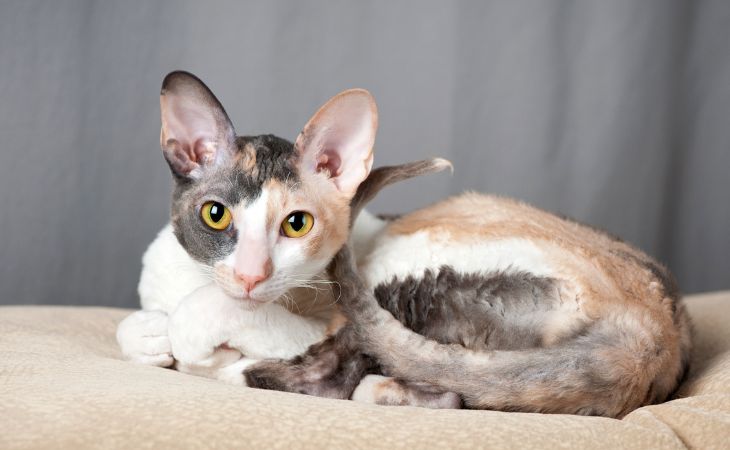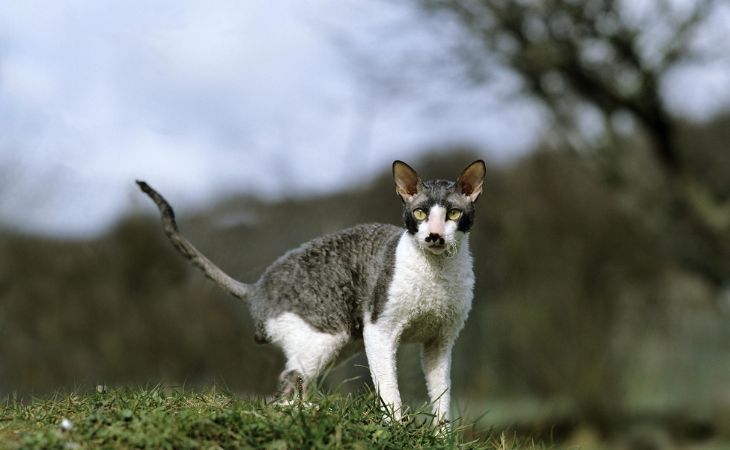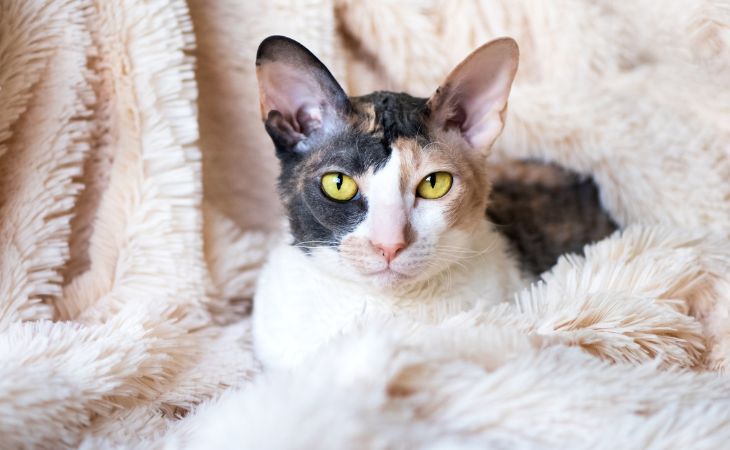Breed standard: CFA, FIFe, TICA, ACF, ACFA/CAA, CCA-AFC, GCCF I Size: Medium I Average lifespan: 14+ years I Temperament: Intelligent, friendly, and playful I Coat: Short I Origin: Great Britain.
The Cornish Rex is a medium cat with a short coat. These cats are friendly, kind, and very endearing.
The surprising origins of the Cornish Rex
The breed originates from Great Britain, more precisely from the county of Cornwall.
The result of a spontaneous mutation
The origin of the Cornish Rex is a little surprising. It all started on July 21, 1950, when the owner of an alley cat noticed that one of the cats in the litter did not look like the others. This strange cat had a curly hair, big ears and a tail that looked like that of a rat. Mrs. Ennismore, the owner of the mother cat, named the kitten Kallibunker. Mrs. Ennismore’s vet told her that Kallibunker appeared to look different from the other kittens in the litter because of a genetic mutation. He proposed to the owner to mate the Kallibunker with his mother to see if the characteristics would transfer to his descendants. The results were surprising. In the litter, there were three kittens—one normal female and two male cats that were identical to their father, Kallibunker.
Unfortunately, one of the male kittens passed away at 7 months. The second male kitten, named Poldhu, was mated with other breeds such as the Siamese cat, the Russian Blue, the British Shorthair, and the Havana Brown. Several litters possessed the gene of their grandfather. The different crosses that were made with Poldhu allowed Kallibunker’s descendants to be different colors. This new breed was named the Cornish Rex because of its origin (Cornwall) and its coat which was similar to Astrex rabbits. Poldhu became sterile after a series of experiments. Nowadays, Cornish Rex cats are descendants of Poldhu.
Heading for the Americas!
The first voyage of a member of the family of Cornish Rexes from Great Britain happened in 1957. Lamorna Cove was brought to the north of the United States in 1957 after being crossed with her father, Poldhu. Some time after her arrival in the United States, she brought to the world four kittens. Two of these four kittens were taken by Helen Weiss and Peggy Galvin who succeeded in crossing them with Siamese cats, Oriental shorthairs, and other cat breeds with thin frames. This breed was very successful and grew popular quickly, attracting the attention of affection of the public and cat lovers alike.
The Cornish Rex nowadays
The Cornish Rex was officially recognized in the United States in 1964 and in the United Kingdom in 1967. However, to get there, the breed needed to be saved from extinction that was threatened with the death of Kallibunker and an accidental sterilization of Poldhu. We owe the presence of the Cornish Rex to the American, Helen Weiss. She continued to breed this breed by crossing Marmaduke, a male cat from Lamorna Cove, with short-haired female cats.
Today, the Cornish Rex is ranked between 10th and 15th place in the United States. However, the breed has seen a decline in Europe. Since 2009, we record around 80 births every year in France and in Great Britain.
What is this cat’s temperament like?
Cornish Rexes are intelligent, playful, and friendly pets.
The Cornish Rex’s qualities
This cat breed is soft, very intelligent, active, and agile. They are great athletes and playful cats. As these cats are very endearing, they search for their owners everywhere. They are very friendly and love the company of their family. They are the ideal cat for children and people who live alone. In addition, they are fine with living with other pets in their household (other cat breeds, dogs, etc.).

What are the downsides of having a Cornish Rex?
Cornish Rexes have shrill meows, but are full of affection. They don’t like living alone. Their affectionate character and sensitivity makes them constantly search for caresses and attention.
Keep your kitchen cabinets locked if you have a Cornish Rex! With this cat, raids are frequent. For this reason, your prized possessions should never be in their reach.
Lastly, as the fur of this cat breed is thin, they are sensitive to the cold. Therefore, it is not an outdoor cat. They like living in apartments, but they must also have enough space to run and jump. They like spending time near sources of heat such as fireplaces, heaters, and blankets.
The Cornish Rex’s physical characteristics
General
This cat breed is medium sized. The length and finesse of their body gives them a unique look. The sexual dimorphism is easily recognizable, and the male cats are generally bigger than females.

Head
The head of the Cornish Rex is long and triangular with a flat skull. The small head of this animal has very big ears. They have a cone shape and the ends are rounded.
The eyes are also very big, oval shaped, and slightly oriented upwards. The eyes can be gold, green, or hazelnut colored based on the color of their coat.
This breed is different from other breeds because of their curved whiskers. Just like their coat, their whiskers are also curly.
Body
The Cornish Rex is the most refined domestic feline, with a thin bone structure, well-developed muscles, long and strong paws and a long, thin tail. The back paws are higher than the front paws. In addition, this cats has long toes that they can use like little fingers.
Coat, color, and grooming
Coat
The Cornish Rex’s body is covered with curly, thin, and soft hairs. The Cornish Rex’s curly coat also covers the head and the long tail.
Coat color
All colors and patterns are accepted. This breed can have a white, black, blue, red, cream, or chocolate coat. The pattern can be tabby, calico, tortoise shell, bicolor, or colorpoint. Depending on the color of the coat, the eyes can be gold, green, or a hazelnut color.
Caring for your Cornish Rex
The Cornish Rex does not require special care. You will only need to wash the inside of their ears with a gentle Cornish Rex ear cleaning solution once a week. In addition, Cornish Rex’s only need to be brushed once a week. You can simply pass your hand over your Cornish Rex’s coat, which is recommended for cats with short hair.
It is important to avoid brushing this breed too often or pushing too hard because it can damage their fur. Regular baths are only necessary for Cornish Rexes with a white coat. The goal is to prevent the coat from losing its shine.
It’s also important to keep an eye on their claws in order to trim them if necessary. When grooming your cat, do not forget to keep an eye on your cat’s eyes and teeth.
Did you know?
The Cornish Rex likes to bring objects with them. For this reason, they are often compared to dogs. It also makes them a really special cat.
The Cornish Rex at a glance
Size: 35 to 40 centimeters for both females and males (around 13.7 to 15.7 inches).
Weight: 3 to 6 kilograms (around 6.6 to 13.2 pounds).
Health: The Cornish Rex is a healthy cat. However, their unique coat makes them sensitive to low temperatures.
Average lifespan: 14 to 15 years.
Are Cornish Rexes good with children? The Cornish Rex is well-adapted to spending time with children.

